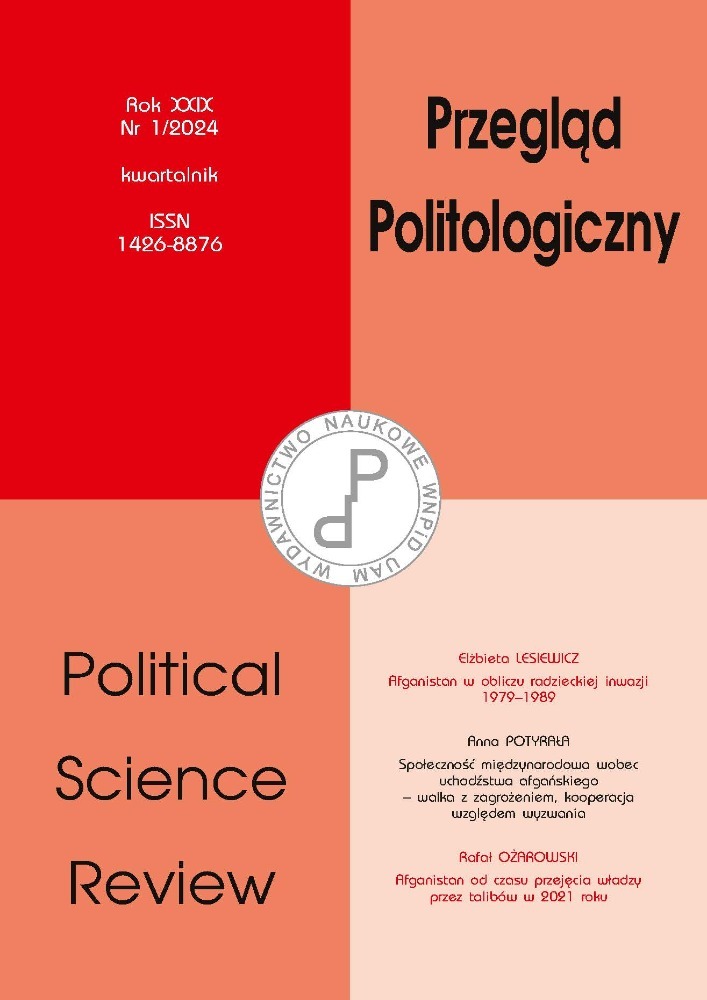Abstrakt
Zwycięstwo Talibów w Afganistanie w 2021 r. nie tylko wzbudziło obawy geopolityczne, ale także wywołało pytania o politykę i strategie państwa dotyczące rezerw metali ziem rzadkich. Głównym celem niniejszego artykułu jest wskazanie, jak obecne zmiany polityczne w Afganistanie mogą wpłynąć na politykę surowcową w zakresie wydobycia metali ziem rzadkich, uwzględniając czynnik geopolityczny. Omawiane metale to grupa minerałów krytycznych o ogromnym znaczeniu dla nowoczesnych technologii, począwszy od elektroniki i energii odnawialnej, po systemy obronne. Wiadomo, że Afganistan posiada znaczne złoża tych cennych zasobów, które mogą potencjalnie odegrać kluczową rolę w globalnych łańcuchach dostaw, zwłaszcza w obliczu nieustającej rywalizacji między Chińską Republiką Ludową a Stanami Zjednoczonymi. Problem badawczy podjętych w tym artykule rozważań polega na ocenie kluczowych wyzwań i szans w wykorzystaniu metali ziem rzadkich w Afganistanie po powrocie Talibów do władzy pomimo zawiłości geopolitycznej. Z przeprowadzonych badań wynika, że pomimo posiadania znacznych ilości pierwiastków ziem rzadkich, Afganistanowi brakuje infrastruktury niezbędnej do wydobywania i przetwarzania tych cennych minerałów. Po zwycięstwie Talibów, nowo utworzony rząd dostrzega potencjalne korzyści z wydobycia metali ziem rzadkich i jest skłonny sprzymierzyć się z Chinami w celu ich eksploatacji.
Bibliografia
Afghanistan Extractive Industries Transparency Initiative (2016), Inception Report and Fourth Reconciliation Report, https://eiti.org/sites/default/files/attachments/2012-2013_afghanistan_eiti_report.pdf, 12.01.2024.
Baskaran G. (2024), What China’s Ban on Rare Earths Processing Technology Exports Means, https://www.csis.org/analysis/what-chinas-ban-rare-earths-processing-technology-exports-means, 10.01.2024.
Cash J., Noori M., Greenfield Ch. (2023), Taliban plans to formally join China’s Belt and Road Initiative, https://www.mining.com/web/taliban-says-plans-to-formally-join-chinas-belt-and-road-initiative/, 22.12.2023.
Chandrashekar TS. (2021), The Great Game over Rare Earth Minerals in Afghanistan, https://samvadaworld.com/big-block-of-4/the-great-game-over-rare-earth-minerals-in-afghanistan/, 8.12.2023.
Dobrescu E. (2023), The Rare Earths Economy, MultiMedia Publishing, Bucharest. DOI: https://doi.org/10.58679/tw70453
European Commission (2023), Batteries and mining, https://knowledge4policy.ec.europa.eu/biodiversity/batteries-mining_en, 15.09.2023.
Fazl-e-Haider S. (2023), Is China engaged in resource politics in Afghanistan?, https://www.thinkchina.sg/china-engaged-resource-politics-afghanistan, 04.12.2023.
Ginsburgs G. (1987), Calendar of Soviet Treaties, Martinus Nijhoff Publishers, Dordrecht.
Global Times (2021), US in no position to meddle with potential rare-earth cooperation between China and Afghanistan, https://www.globaltimes.cn/page/202108/1231893.shtml, 20.12.2023.
Haynes J. (2008), Development Studies, Polity Press, Cambridge.
Hussein M., Haddad M. (2021), Mapping Afghanistan’s untapped natural resources, https://www.aljazeera.com/news/2021/9/24/mapping-afghanistans-untapped-natural-resources-interactive, 21.12.2023.
Kalantzakos S. (2018), China and the geopolitics of rare earths, Oxford University Press, New York. DOI: https://doi.org/10.1093/oso/9780190670931.001.0001
Marlow I., Curran E. (2021), As US exits Afghanistan, China eyes 1$ trillion in minerals, https://www.aljazeera.com/news/2021/8/24/as-us-exits-afghanistan-china-eyes-1-trillion-in-minerals, 19.12.2023.
Ministry of Mines and Petroleum (2019), Afghanistan – Mining Regulations 2019, https://policy.asiapacificenergy.org/node/4062, 12.01.2024.
Montgomery S. (2021), Afghanistan has vast mineral wealth but faces steep challenges to tap it, https://theconversation.com/afghanistan-has-vast-mineral-wealth-but-faces-steep-challenges-to-tap-it-166484, 24.09.2023.
Nguyen M., Onstad E. (2023), China’s rare earths dominance in focus after it limits germanium and gallium exports, https://www.reuters.com/markets/commodities/chinas-rare-earths-dominance-focus-after-mineral-export-curbs-2023-07-05/, 02.01.2024.
Nojumi N. (2016), American State-Building in Afghanistan and Its Regional Consequences. Achieving Democratic Stability and Balancing China’s Influence, Rowman and Littlefield Publishers, Lanham.
Polish Economic Institute (2023), 98% of EU demand for rare-earth elements is met by China, https://pie.net.pl/en/98-of-eu-demand-for-rare-earth-elements-is-met-by-china/, 12.11.2023.
Rosenberg J. M. (2022), The Belt and Road Initiative. The Threat of an Economic Cold War with China, Lexington Books, London.
Saunders P. (2021), Energy technology in an Era of Great Power Competition. Challenges and Opportunities in U.S.-Japan and U.S.-South Korea Cooperation, Energy Innovation Reform Project, Arlington.
Schneider H. (2024), Beijing’s motivation in China-Taliban relations, https://www.gisreportsonline.com/r/china-taliban-relations/, 16.03.2024.
Shroder J. (2014), Natural Resources in Afghanistan, Elsevier, San Diego. DOI: https://doi.org/10.1016/B978-0-12-800135-6.00014-3
Smelror M., Hanghoj K., Schiellerup H. (2023), The Green Stone Age: Exploration and Exploitation of Minerals for Green Technologies, The Geological Society Publishing House, Brassmill Lane. DOI: https://doi.org/10.1144/SP526
Specialeurasia (2023), Exploring Iran-Afghanistan collaboration: Kabul’s Pursuit of Trade Diversification, https://www.specialeurasia.com/2023/12/04/iran-afghanistan-cooperation/, 03.01.2024.
Tan W. (2021), China may align itself with Taliban and try to exploit Afghanistan’s rare earth metals, analyst warns, https://www.cnbc.com/2021/08/17/taliban-in-afghanistan-china-may-exploit-rare-earth-metals-analyst-says.html, 20.09.2023.
The Economic Times (2023), Chine eyes Afghanistan’s lithium reserves, offers to invest USD 10 billion, https://economictimes.indiatimes.com/news/international/world-news/china-eyes-afghanistans-lithium-reserves-offers-to-invest-usd-10-billion/articleshow/99521732.cms?from=mdr, 03.01.2024.
Tiess G., Majumder T., Cameron P. (2023), Encyclopedia of Mineral and Energy Policy, Springer, Berlin. DOI: https://doi.org/10.1007/978-3-662-47493-8
Trumpwhitehouse (2017), Readout of President Donald J. Trump’s Meeting with President Ashraf Ghani of Afghanistan, https://trumpwhitehouse.archives.gov/briefings-statements/readout-president-donald-j-trumps-meeting-president-ashraf-ghani-afghanistan/, 22.10.2023.
Trumpwhitehouse (2020), President Donald J. Trump Is Protecting Our Domestic Mining Industry and Critical Minerals Supply Chains, https://trumpwhitehouse.archives.gov/briefings-statements/president-donald-j-trump-protecting-domestic-mining-industry-critical-minerals-supply-chains/, 23.10.2023.
U.S. Department of the Interior, U.S. Geological Survey (2013), Minerals Yearbook. Area Reports: International 2013. Asia and the Pacific, United States Government Printing Office, Washington.
United States Geological Survey (2011), Summaries of Important Areas for Mineral Investment and Production Opportunities of Nonfuel Minerals in Afghanistan, https://pubs.usgs.gov/of/2011/1204/, 21.11.2023.
Wilson M. B. (2013), Impacts of Participatory Development in Afghanistan, Walter de Gruyter, Berlin. DOI: https://doi.org/10.1515/9783112209059
Yunus Yawar M. (2022), China „shocked” at Kabul hotel attack that injured its five citizens, https://www.reuters.com/world/asia-pacific/five-chinese-citizens-badly-injured-kabul-attack-businessman-says-2022-12-13/, 04.12.2023.
Licencja
Prawa autorskie (c) 2024 Rafał Kamprowski

Utwór dostępny jest na licencji Creative Commons Uznanie autorstwa – Na tych samych warunkach 4.0 Miedzynarodowe.

